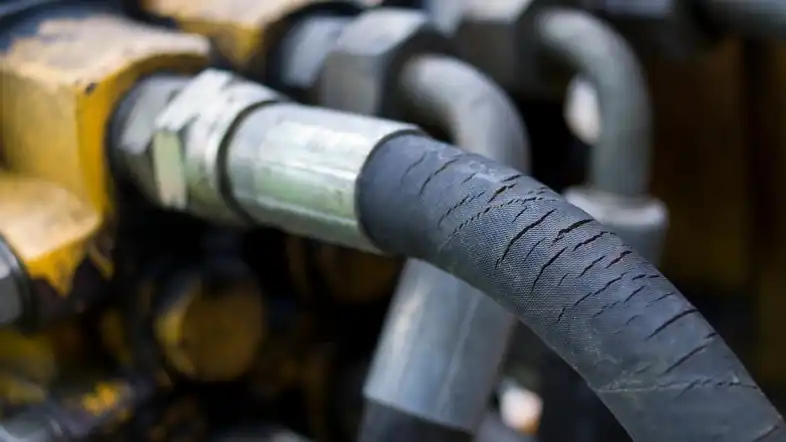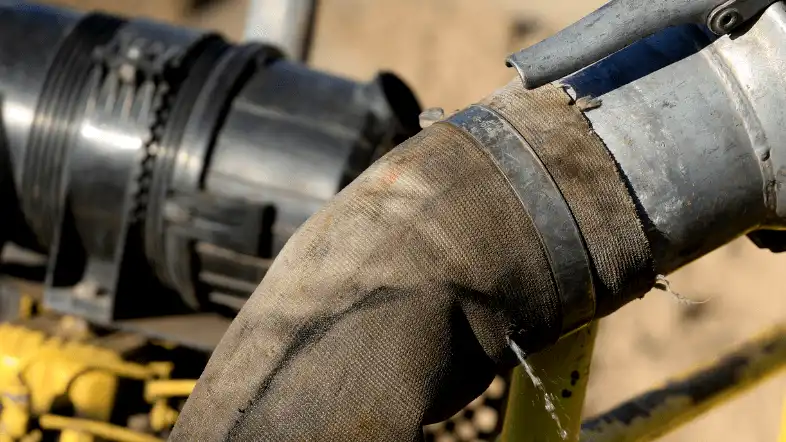Understanding Hydraulic Hose Repair
Hydraulic hoses are crucial components in various machinery, from construction equipment to automobiles.
They can, however, suffer from wear and tear, leading to leaks, cracks, and other issues. Quick fix hydraulic hose repair kits are designed to help you tackle these problems on the spot, reducing downtime and costs.
Importance of Quick Fix Hydraulic Hose Repair Kits

Why a quick fix hydraulic hose repair kit is essential?
Quick fix hydraulic hose repair kits play a crucial role in maintaining hydraulic systems, as they allow operators to address hose issues quickly and effectively without the need for extensive training or specialized tools. The importance of quick fix hydraulic hose repair kits lies in the following aspects:
Reducing Downtime:
Hydraulic systems are critical in maintaining the smooth functioning of heavy machinery, from construction equipment to industrial processes. Minimizing downtime when hydraulic hoses fail is vital to keeping production lines running efficiently. Quick fix hydraulic hose repair kits provide operators with the necessary components to address hose issues on-site, allowing them to get machines up and running as soon as possible.
Cost-Effective Solution:
Replacing an entire hydraulic hose can be costly, especially if the damaged section is only a few feet long. Quick fix hydraulic hose repair kits offer a more affordable solution, allowing operators to cut out the damaged section and replace only the affected portion without having to purchase a new hose.
Ensuring Safety:
Failed hydraulic hoses can lead to safety hazards, such as loss of power, leaks, or system overload. Quick fix hydraulic hose repair kits ensure that machines operate safely by addressing hydraulic hose issues promptly. Using properly installed and secured clamps and connectors minimize the risk of hose failure, resulting in fewer safety incidents.
Minimizing Waste:
Hydraulic hoses are expensive, and throwing away a damaged hose just because of a small section of damage can be costly. Quick fix hydraulic hose repair kits offer an eco-friendly solution by allowing operators to repair and reuse the damaged hose, reducing waste and promoting sustainability.
Speed:
Quick fix hydraulic hose repair kits enable operators to complete repairs in a matter of minutes, thanks to the convenience of pre-cut clamps, shaped clamps, and other components designed for quick assembly. With these tools at hand, even inexperienced users can accomplish repairs quickly and efficiently.
Convenience:
Quick fix hydraulic hose repair kits come with everything you need to complete a repair, including hose clamps, hose repair clamps, hose crimping tools, and more. These all-inclusive kits make it easier to plan and prepare for repairs, as you don’t need to worry about purchasing additional tools or spare parts.
Customizability:
Most quick fix hydraulic hose repair kits are available in various sizes to cater to different hydraulic systems. Additionally, many kits include multiple clamp types and configurations, allowing operators to adjust the repair kit to the specific needs of their hydraulic system.
Flexibility:
Quick fix hydraulic hose repair kits are designed to work with various types of hydraulic systems, including hydraulic excavators, pumps, generators, compressors, and more. This flexibility allows operators to use the same repair kit for multiple applications, reducing the need for different kits for every machine.
Ability to Adapt to Different Applications:
As technology advances, new types of hydraulic systems are being developed. Quick fix hydraulic hose repair kits often incorporate new components and adaptable design features, allowing users to address issues across various applications and industries. This adaptability ensures that quick fix hydraulic hose repair kits remain a valuable asset in the face of changing industry demands.
Quick fix hydraulic hose repair kits play a crucial role in maintaining hydraulic systems by reducing downtime, providing a cost-effective solution, ensuring safety, minimizing waste, speeding up repairs, offering convenience, customizability, and flexibility. These kits make hydraulic hose repairs accessible to a wide range of users, contributing to the efficient operation and longevity of hydraulic machinery.
The Anatomy of a Hydraulic Hose
To understand hydraulic hose repair, it’s essential to know the hose’s construction. A typical hydraulic hose consists of an inner tube, reinforced layers, a cover, and fittings. Each component plays a vital role in the hose’s performance and durability.
Common Hydraulic Hose Issues

Hydraulic hoses can crack and leak due to factors such as excessive pressure, damage from foreign objects, aging, or exposure to extreme temperatures. As a result, hydraulic fluid can leak out, leading to machinery malfunction or safety hazards. Leaks can be identified by visibly wet areas on the hose and reduced machine performance.
2. Bulging and kinking
Hydraulic hoses can bulge or kink over time due to flexing under pressure or physical damage. These defects weaken the hose wall, making it more susceptible to internal leaks and eventual collapse. Bulging can be seen along the length of the hose, while kinks are evident as noticeable bends in the hose’s shape.
3.1. Abrasion and Wear
Continuous pressure and friction from movement or machinery components can cause hydraulic hoses to wear and fray over time. This abrasion leads to structural weakness and eventually cracks in the hose wall, resulting in the potential for leaks and hydraulic system failure. Regular inspections and proper handling can help minimize damage from abrasion.
4. Swelling or blistering
Hydraulic hoses can swell or blister due to the absorption or heat build-up within the hydraulic fluid. Swollen hoses can weaken the hose wall and potentially cause bubbles, resulting in internal hydraulic leaks, reduced performance, and eventual catastrophic failure. Identifiable signs include bulges, irregularities in the hose circumference, or blistered areas.
5. Stuck piston rods and seals
During operation, the hydraulic fluid may lose lubrication or contaminated, causing piston rods and seals to stick or seize. Excessive heat or friction in the system can accelerate damage to these components, ultimately leading to pressure build-up and possible explosions or machinery failure. Signs of this issue may include excessive heat at the cylinder or abnormal sealing problems.
6. Internal damage
Hydraulic hoses can be damaged during installation or while the machine is running, resulting in internal cracks and blisters that may not be noticeable on the outside. Overheating, chemical reactions between different hose materials, or internal pressure shifts can also contribute to internal damage. Detecting internal damage may prove challenging, necessitating careful ultrasonic or visual inspections.
7. Improper hose installation
Insufficiently securing, bending, or kinking of hydraulic hoses can lead to a host of problems over time. For example, poorly anchored hoses can rub and wear against machinery components, weakening the hose structure or restricting movement, which may reduce performance and create stress points resulting in cracks and leaks.
8. Using Incompatible Hoses and Fittings
Incorporating unsuitable hoses or fittings into a hydraulic system based on pressure, material or durability ratings can result in increased brittleness, corrosion, or internal damage, accelerating the deterioration of these components. Selecting appropriate and compatible hydraulic system components is crucial for a proper running system.
9. Physical Damage
Accidents or collision can lead to immediate damages to the hydraulic hose’s structure. Punctures, gouges or knicks may be apparent depending on the severity of the damage but even slight physical injuries must be assessed carefully because they can still cause future catastrophic failure.
Addressing common hydraulic hose issues is crucial to maintain your machinery’s optimal performance while ensuring the safety of the operators, as prompt identification and resolution significantly reduce downtime and maintenance expenses. Regular inspections and timely repairs with quick fix kits will ensure a higher level of operational reliability across your hydraulic equipment for the long run.
Components of a Quick Fix Hydraulic Hose Repair Kit
A comprehensive quick fix hydraulic hose repair kit includes various components such as hose clamps, repair clamps, hose connectors, a hose cutter, and a hose crimping tool. Each component plays a crucial role in ensuring a successful repair.
How to Use a Quick Fix Hydraulic Hose Repair Kit

Using a quick fix hydraulic hose repair kit involves a few straightforward steps that don’t require extensive skills or experience:
Step 1: Identify the Problem
Examine the hydraulic system for signs of damage, such as leaks or abnormal operation. Inspect the hose and connections for visible defects or visible signs of potential problems. In some cases, it might be necessary to perform leak testing or ultrasonic inspections to identify the exact problem and require further repair or replacement.
Step 2: Cut the Damaged Section
Once you have located the damaged portion of the hydraulic hose, use a hose cutter to make clean, square cuts at the ends of the damaged section.a hose cutter to make clean, square cuts at the ends of the damaged section. Always be sure you have the appropriate cutter for your hose material and diameter, as using the wrong cutter can compromise the integrity of the freshly cut ends.
Step 3: Prepare the Ends
Remove any damaged or contaminated rubber from the cut ends using a wire brush or a scraper. This step is essential to make sure the repaired ends are hard and wear-resistant. If necessary, you can use a hose grip system or fresh adhesive to create a secure fit between the gloves and the ends of the hose to create proper seals.
Step 4: Connect the New Section
Fit the new section of the hose to the existing machine using appropriate clamps and connectors. It’s important to ensure that the new section of the hose is properly crimped to prevent leaks and secure connections. Ensure the new hose is aligned with the connections on the hydraulic system before crimping for the best results.
Step 5: Secure the Repair
Make sure the clamps are tightly fastened and properly orientated to distribute the load evenly. Crimp the connection using the included crimping tool, making sure that the line is tight and the connections are secure. Double-check the repair by pulling on the clamps, ensuring they are experienced enough to make sure the connection is stable enough for use.
Tip: If you are new to using quick fix hydraulic hose repair kits and need additional assistance, follow the manufacturer’s specific guidelines or consider reaching out to their customer support team to ensure a successful repair.
Tips for Effective Hydraulic Hose Repair
To ensure successful hydraulic hose repair, consider these tips:
- Choose the right repair kit: Select a kit suitable for your hydraulic hose’s size, pressure, and material.
- Proper maintenance: Ensure regular inspections, cleaning, and replacement of hoses to prevent sudden failures.
- Inspect the hydraulic system regularly: Regularly check the entire hydraulic system for any leaks or damage.
Common Mistakes to Avoid During Hydraulic Hose Repair
To avoid complications, it’s essential to steer clear of these mistakes:
- Using the wrong type of clamp: Choose clamps designed for the hydraulic hose’s specific application.
- Over-tightening clamps: Excessive force can damage the hose.
- Neglecting hose crimping: Proper crimping ensures a tight, leak-free connection.
When to Replace Instead of Repair
While quick fix hydraulic hose repairs can save you time and costs, there are cases where replacement is necessary:
- Extensive damage: If the hose has significant wear, cracks, or tears, it’s best to replace it.
- Age of the hose: Older hoses may exhibit deterioration over time, making replacement the more cost-effective option.
- Frequency of repairs: If a hydraulic hose is constantly requiring repairs, it may be time for a new one.
Conclusion
Quick fix hydraulic hose repair kits are a game-changer for those working with hydraulic machinery, enabling them to perform repairs quickly and efficiently. With a bit of knowledge and the right tools, fixing hydraulic hose issues becomes a manageable task.
FAQ
Can I use a quick fix hydraulic hose repair kit on any type of hydraulic hose?
Yes, most quick fix hydraulic hose repair kits come with various types of clamps and connectors to accommodate different hydraulic hose applications.
How long does a quick fix repair last?
The lifespan of a quick fix repair depends on factors like the hose’s condition, usage, and maintenance. Regular inspections and proper care can extend the repair’s life.
Is it safe to use a repaired hydraulic hose?
Yes, a properly repaired hydraulic hose is safe to use as long as the repair was done according to the manufacturer‘s guidelines and proper safety precautions were taken.
Can I reuse the clamps from a quick fix repair kit?
It’s generally not recommended to reuse clamps from a quick fix repair kit, as they may have been compromised during the previous repair.
How often should I inspect my hydraulic hoses?
It’s recommended to inspect hydraulic hoses at least once a month, or more frequently in high-use or high-stress applications, to identify any potential issues before they result in major damage.

